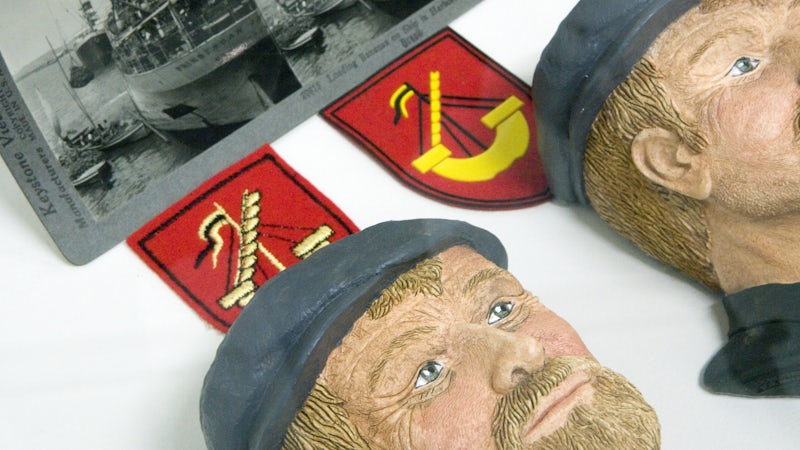Allan Sekula

The Dockers’ Museum
In Antwerp in 2010, Allan Sekula (1951, Erie, Pennsylvania, 2013, Los Angeles) mooted an idea for a museum that strongly criticises the large-scale collection mania and materialistic superficiality at the start of 21st century. The Dockers’ Museum was initially an undivided property in which the objects symbolically belonged to the museum as a supporter of public domain, and the museum and insights to the artist. The theme is the dockworker as the personification of a transition zone between ship and shore, a dynamic and living border area.
Upon the demise of Allan Sekula in 2013, the entire museum came into the hands of the M HKA. That is when it became apparent that the Dockers’ Museum contained more than 1,250 items. Here, the question arose as to how to manage, display or open an ambiguous collection or ‘anti-archival material’ today.
In an intense collaboration between the M HKA and the KU Leuven, a pilot project was launched in which the new field of research-based curatorship and an extensive museum research meet. The research project is divided into two PHD projects where theory and practice intersect. In addition, the M HKA launched a parallel project for inventory, digitisation, photography and description. In addition to a physical custody, a comprehensive database has been developed that will form the backbone for a new online catalogue raisonné.
Please join us on September 29, 2016 between 6 and 7:30 PM for an informal book launch event of Allan Sekula: Mining Section (Bureau des mines). Collaborative Notes. This publication accompanies the research presentation Allan Sekula: Mining Section (Bureau des mines) at the Anatomical Theater in Leuven, curated by Anja Isabel Schneider. It gives a provisional glimpse into Allan Sekula’s compulsive collecting of more than 1200 objects for his last work: The Dockers’ Museum, now part of the collection of M HKA, Museum van Hedendaagse Kunst Antwerpen.
Sekula imagined and set out to realize The Dockers’ Museum as an artistic venture that makes the struggles of miners, dockworkers, and seafarers visible through networks of metonymic objects that embody these workers’ imaginaries. In Allan Sekula: Mining Section (Bureau des mines), Anja Isabel Schneider proposes a speculative reading of one of the artwork’s loosely defined sections, the so-called “Bureau of Mines.” This presentation is part of the exhibition Tracing the Future, curated by Stéphane Symons, Hilde Van Gelder, and Eva Wittocx (see details below).
Published by ARA, the artistic research series of MER. Paper Kunsthalle and edited by Nicola Setari and Hilde Van Gelder, the accompanying book is the first truly posthumous book publication on aspects of Allan Sekula’s The Dockers’ Museum. It includes contributions by Mieke Bleyen, Edwin Carels, Bart De Baere, Anja Isabel Schneider, Nicola Setari, Hilde Van Gelder, and Jeroen Verbeeck — who engaged in a close dialogue all through its making process.
Both the publication and the presentation are the first major results of research jointly carried out between the Lieven Gevaert Research Centre for Photography, Art and Visual Culture (LGC) and M HKA on Sekula’s Ship of Fools / The Dockers’ Museum (2010-2013). Funded by KU Leuven’s Research Fund and the Research Foundation-Flanders, this five year-long research project (2014-2019) includes two PhD trajectories currently carried out by Jeroen Verbeeck (KU Leuven) in Art History and Anja Isabel Schneider (KU Leuven/M HKA) in Curatorial Research.
Tracing the Future is a contemporary art exhibition organized as part of the urban project 500 YEARS UTOPIA – LEUVEN. Realized by KU Leuven and M – Museum Leuven, it enquires how Thomas More’s Utopia, published in Leuven in 1516, can still be a source of inspiration for artists today. Tracing the Future addresses this question while bringing together films and installations, both recent and new work, by leading contemporary artists. Tracing the Future encompasses a solo exhibition of Yto Barrada at M – Museum as well as works by Ursula Biemann & Paulo Tavares and Martin Le Chevallier on view at KADOC, by The Otolith Group in the University Library, by Adrien Tirtiaux in the City Park, and by Allan Sekula in the Anatomical Theater. The artworks on display offer a critical look at the ecological, political and social impact of modern-day utopias. They refer to the success but also the failure of the quest for the ideal world. The selected artists draw our attention both to unattainable utopias from the past and to pressing contemporary issues.


